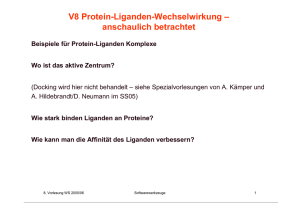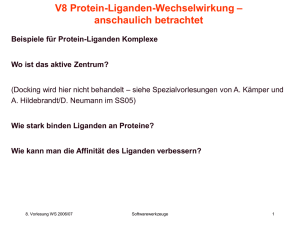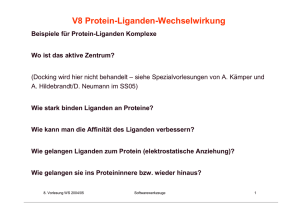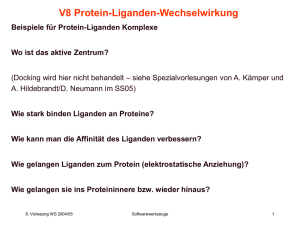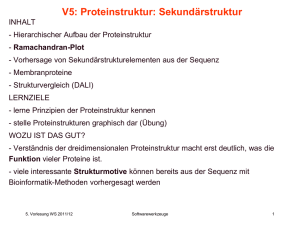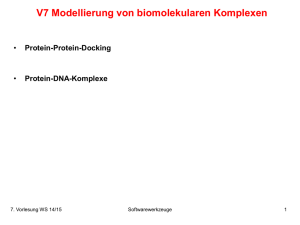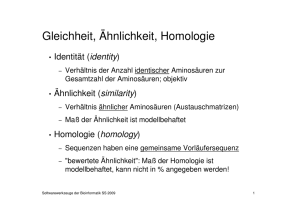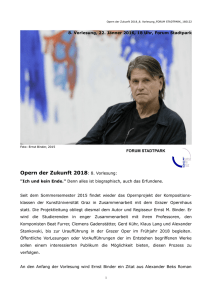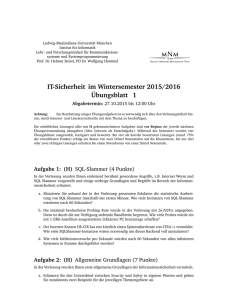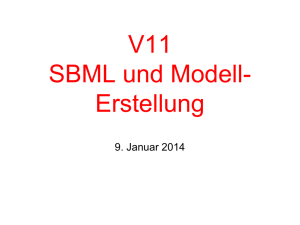V8 Protein-Liganden-Wechselwirkung – anschaulich betrachtet
Werbung
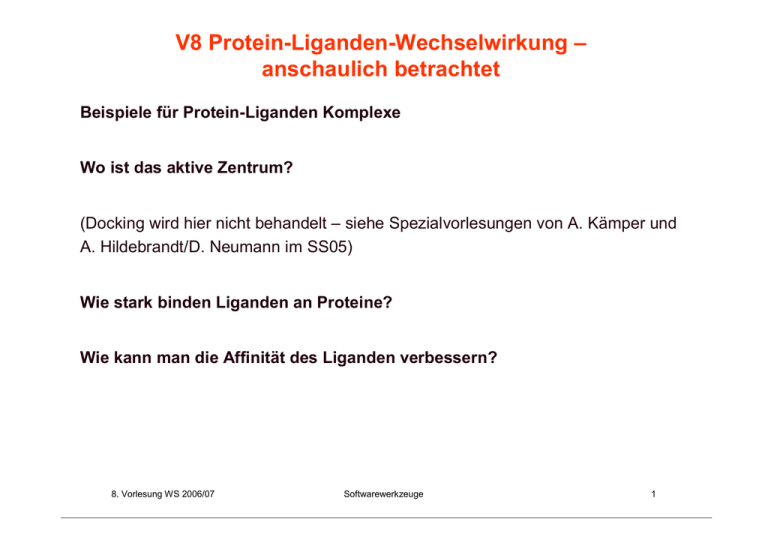
V8 Protein-Liganden-Wechselwirkung – anschaulich betrachtet Beispiele für Protein-Liganden Komplexe Wo ist das aktive Zentrum? (Docking wird hier nicht behandelt – siehe Spezialvorlesungen von A. Kämper und A. Hildebrandt/D. Neumann im SS05) Wie stark binden Liganden an Proteine? Wie kann man die Affinität des Liganden verbessern? 8. Vorlesung WS 2006/07 Softwarewerkzeuge 1 beta-Trypsin:Benzamidin (3ptb) Enge, sehr polare Bindungstasche auf Proteinoberfläche. Amidin-Gruppen des Liganden bilden 4 HBindungen mit Carboxylgruppen des Proteins (Trypsin) aus. Benzolring passt optimal in hydrophobe Tasche. www.scripps.edu/pub/olson-web/doc/autodock 8. Vorlesung WS 2006/07 Softwarewerkzeuge 2 Cytochrome P450cam : Kampher (2cpp) Weites, recht unpolares aktives Zentrum im Proteininneren. Hämgruppe katalysiert Reaktion. Partielle Desolvatation. Wie gelangt Substrat hinein? www.scripps.edu/pub/olson-web/doc/autodock Softwarewerkzeuge 8. Vorlesung WS 2006/07 3 Maus-Antikörper McPC-603:Phosphocholine (2mcp) Bindungstasche auf Proteinoberfläche wird durch drei hypervariable Loops geformt. www.scripps.edu/pub/olson-web/doc/autodock 8. Vorlesung WS 2006/07 Softwarewerkzeuge 4 Streptavidin:Biotin (1stp) Sehr polare, tiefe Bindungstasche. Außerordentlich starke Affinität. www.scripps.edu/pub/olson-web/doc/autodock 8. Vorlesung WS 2006/07 Softwarewerkzeuge 5 HIV-1 Protease:XK-263 Inhibitor (1hvr) Inhibitor XK-263 stammt von Merck-Dupont. Er enthält eine 7-Ring zyklische Urea-Einheit mit Phenyl- und Naphtyl-Ringen. Die CO-Gruppe ahmt das ansonsten konservierte Wassermolekül 301 nach und verdrängt es. Der tiefere Teil des zyklischen Urea-Rings enthält zwei benachbarte Hydroxylgruppen, die H-Bindungen mit den katalytischen Aspartat-Residuen bilden. 8. Vorlesung WS 2006/07 www.scripps.edu/pub/olson-web/doc/autodock6 Softwarewerkzeuge Identifikation von funktionellen Residuen 1 Funktionelle bzw. katalytische Residuen werden traditionell in (hoch) konservierten Regionen von Multiple Sequence Alignments erwartet evtl. Kopplung mit Information über 3D-Struktur 2: finde Residuen, die Proteinstruktur destabilisieren. Grund: Funktionelle Residuen im Proteininneren sind oft energetisch ungünstig. Funktionalität auf Kosten von Stabilität. 3: finde Löcher oder Einbuchtungen in Proteinstruktur. Hier vorgestellt: integrierte Methode, die 1 -3 implementiert. Möglichkeit für funktionelle Annotation von Proteinen mit unbekannter Funktion. 8. Vorlesung WS 2006/07 Softwarewerkzeuge 7 Wo ist das aktive Zentrum I? Auswahl von 49 Enzymen. Kriterien: - Auflösung 2.0 Å - funktionelle Residuen sind bekannt (in Swissprot-Eintrag in ACT_SITE) - enthalten nur eine Domäne (SCOP Datenbank) - die SCOP-Einträge sind unterschiedlich - es gibt 10 homologe Sequenzen mit Blast E-Wert < 10-10. 98 katalytische Residuen: 22 His 17 Asp, Glu 10 Cys 8 Ser 7 Arg, Lys 5 Tyr 3 Asn 2 Thr 8. Vorlesung WS 2006/07 Ota, Kinoshita, Nishikawa, J Mol Biol 327, 1053 (2003) Softwarewerkzeuge 8 Repräsentative Enzyme PDB Protein Länge Auflösung EC SCOP 8. Vorlesung WS 2006/07 Softwarewerkzeuge Zahl Seq. Zahl und Namen der katalytischen Residuen 9 Repräsentative Enzyme 8. Vorlesung WS 2006/07 Softwarewerkzeuge 10 Fitness-Funktion - Bewertung der Seitenketten-Konformation entsprechend Rotamer-Bibliothek - Seitenketten-Packung (wissensbasiert) - Hydratation (wissensbasiert) - Analyse der Proteinoberfläche (MSP-Programm): Zuordnung zu den einzelnen Residuen - elektrostatische Energie: AMBER-Partialladungen × elektrostatisches Potential (aus Poisson-Boltzmann-Rechnung) Jeder Score(S), Rang (R) und Position (L) werden gegen den Mittelwert und die Standardabweichung für jeden Aminosäuretyp normalisiert. Ota, Kinoshita, Nishikawa, J Mol Biol 327, 1053 (2003) 8. Vorlesung WS 2006/07 Softwarewerkzeuge 11 Vorhersage katalytischer Residuen in Enzymen Beispiel: 3D-Profil für Lysozym aus Hühnereiweiss. D52 ist katal. Residue. native Residue Hydratations- lokale klasse Struktur D52 hat sehr schlechten Rang. D.h. es wäre günstig D52 zu ersetzen. Katalytische Residuen sind stets unstabiler als nicht-katalytische. Score Rang Score native native beste Residue Residue Residue 8. Vorlesung WS 2006/07 Ota, Kinoshita, Nishikawa, J Mol Biol 327, 1053 (2003) Softwarewerkzeuge 12 Vorhersage katalytischer Residuen in Enzymen Flussdiagramm der Vorhersagemethode. - Links oben Analyse der Konservierung. - Rechts oben Analyse der Position in 3D-Struktur bzw. Stabilität der Mutantenproteine - untere Hälfte trifft für verschiedene Aminosäuretypen (1-Letter-code) die Entscheidung, ob katalytische Residuen vorliegen. Ota, Kinoshita, Nishikawa, J Mol Biol 327, 1053 (2003) 8. Vorlesung WS 2006/07 Softwarewerkzeuge 13 Vorhersage katalytischer Residuen in Enzymen Proteinstrukturen mit unbekannter Funktion. Die vorgeschlagenen katalytischen Residuen sind markiert. Ota, Kinoshita, Nishikawa, J Mol Biol 327, 1053 (2003) 8. Vorlesung WS 2006/07 Softwarewerkzeuge 14 Wo ist das aktive Zentrum II Analyse mit elektrostatischen Kontinuumsrechnungen pH = pK a + log [A ] [HA] Die Titrationszustände der meisten Aminosäuren folgen der Henderson-Hasselbalch-Gleichung. Berechne Titrationskurven für 3 Enzyme mit UHBD. TIM und AR haben eine sehr ähnliche Strukturen, katalysieren aber ganz unterschiedliche Reaktionen. Ondrechen, Clifton, Ringe, PNAS 98, 12473 (2001) AR und PMI haben sehr verschiedene Strukturen, katalysieren aber ähnliche Reaktionen. 8. Vorlesung WS 2006/07 Softwarewerkzeuge 15 Theoretische Titrationskurven Titrationskurven aller His-Residuen in TIM Triosephosphat Isomerase (TIM) katalysiert die Isomerierung von D-Glyceraldehyd3-Phosphat zu Dihydroxyaceton-Phosphat. Man findet 4 Residuen mit verschobenen, flachen Titrationskurven: His95, Glu165, Lys112, Tyr164. Ondrechen, Clifton, Ringe, Davon liegen H95, E165 und Y164 eng beieinander. PNAS 98, 12473 (2001) 8. Vorlesung WS 2006/07 Softwarewerkzeuge 16 Theoretische Titrationskurven Titrationskurven aller Tyr-Residuen in AR Ondrechen, Clifton, Ringe, PNAS 98, 12473 (2001) Aldose-Reduktase (AR) katalysiert die Reduktion einer Aldehydgruppe von Aldose zu einem Alkohol. Man findet 7 Residuen mit verschobenen, flachen Titrationskurven: Tyr48, Cys298, Glu185, Lys21, Lys77, Tyr107, Tyr209. Tyr48, His110 und Cys298 bilden das aktive Zentrum. Die anderen Residuen liegen in der Nähe. 8. Vorlesung WS 2006/07 Softwarewerkzeuge 17 Theoretische Titrationskurven Titrationskurven aller Lys-Residuen in PMI Ondrechen, Clifton, Ringe, PNAS 98, 12473 (2001) PMI katalysiert die Interkonversion von Mannose-6-Phosphat und Fructose-6Phosphat. Man findet 4 Residuen mit verschobenen, flachen Titrationskurven: His135, Lys100, Lys136, Tyr287. Alle liegen eng beieinander, die ersten 3 wohl im aktiven Zentrum und His135 nahe bei Lys136. 8. Vorlesung WS 2006/07 Softwarewerkzeuge 18 Weitere Beispiele PDB ID Name 1AMQ Aspartat aminotransferase* Transamination Subtilisin Peptidhydrolyse Carlsberg (Serin-Protease) Acetylcholinesterase Ester Hydrolyse 1CSE 1EA5 1HKA 1OPY 1PIP 1PSO 1WBA Chemie Residuen mit auffälligen Titrationskurven [H189, Y225, K258, R266, C191, C192], [Y256], [Y295], [H301] [D32, H64] [Y130, E199, E327, H440, D392], [Y148], [H398], [H425] [D97, H115] 6-Hydroxymethyl-* Kinase 7,8-dihydropterin pyrophosphate kinase 3-Keto- 5-Steroid Isomerase isomerase Papain Peptidhydrolyse (Cys Protease) Pepsin Peptidhydrolyse (Säure-Protease) Winged bean Speicherung - keine albumin Enzymfunktion Ondrechen, Clifton, Ringe, PNAS 98, 12473 (2001) 8. Vorlesung WS 2006/07 [Y16, Y32, Y57], [C81] [C25, H159], [K17, K174, Y186], [R59], [R96] [D32, D215, D303], [D11] keine Residue im aktiven Zentrum Softwarewerkzeuge Residue im zweiter Schale. 19 Fazit Mittels elektrostatischer Kontinuumsrechnungen für bekannte Kristallstrukturen von Proteinen wurde für verschiedene externe pH-Werte die energetisch optimale Gesamtladung der Proteine berechnet. Aktive Zentren von Enzymen enthalten oft mehrere polare bzw. geladene Seitenketten um die chemische Umwandlung zu katalysieren. Deren Titrationszustände sind eng aneinander gekoppelt und zeigen im Vergleich zu isolierten Seitenketten sehr ungewöhnliche Titrationskurven. Diese Methode erlaubt also die Position von aktiven Zentren allein aufgrund der Proteinstruktur zu erkennen. Ondrechen, Clifton, Ringe, PNAS 98, 12473 (2001) 8. Vorlesung WS 2006/07 Softwarewerkzeuge 20 Wie stark binden Liganden an Proteine? Kuntz, Chen, Sharp, Kollman, PNAS 96, 9997 (1999) 8. Vorlesung WS 2006/07 Softwarewerkzeuge 21 exp. Affinitäten von Protein:Liganden Komplexen # Atome Ligand 1 1 1 1 1 1 1 1 1 2 2 2 2 3 3 4 4 4 5 5 5 6 6 6 7 7 7 8 8 8 9 9 9 9 Ca2+ Hg2+ Mn2+ Fe3+ Ag+ FS2Xe NH3 CO O2 Cyanide Hydroxylamine Azide Ethylamine Thioacetamide NO3Vanadate Thiosemicarbazide SO42Iodoacetamide Putrescine Aminooxyacetic acid Oxalat -Aminobutyid acid L-Cysteine Aminomethiozolidine Muscimol Bromopyrimidone Phosphonoacetic acid Acetopyruvate Methyl iodotyrosine Nitrooxazolidinone Benzamidine Target Typ Amino-transferase IM Uroporphy-synthase IM Inositol-phosphatase IM Hydroxylase IM Arylformamidase IM Phosphotransferase IA Peroxidase IA Myoglobin L Meamine glutamate transferase I Myoglobin L Myoglobin L Methane oxygenase IA Glycerol oxidase IC Glycerol oxidase IA Protease I I Methan monooxygenase I Carbonate deydratase IA Phytase IA Methane monooxygen. I Creatine kinase IA Methyl transferase IC Spermine synthase I Aminotransferase I Lactate dehydrogenase IA Neuromanidase transmitter L Serine acetyl transferase I Methyl transferase I -aminobutylicacid agonist L Cytosine deaminase I DNA polymerase I Acetoacetate decarboxylase I Tyrosine monooxygenase I Aldehyde dehydrogenase I Trypsin I 8. Vorlesung WS 2006/07 -log K1 6.70 6.00 5.70 5.30 5.00 4.55 4.28 2.30 1.79 7.52 6.18 6.00 5.92 5.70 3.00 5.00 4.70 4.55 6.00 5.22 5.00 8.77 7.19 5.80 8.00 6.22 5.40 8.73 6.24 6.00 7.00 6.30 5.46 4.77 Softwarewerkzeuge IM: Metallionischer Inhibitor IA: kleiner anionischer Inhibitor L: Ligand (Agonist oder Antagonist) I: Inhibitor IC: potentiell kovalente Wechselwirkung 22 experimentelle Protein-Liganden Affinitäten # Atome Ligand 10 10 10 11 11 11 12 12 12 13 13 13 14 14 14 15 15 15 16 16 16 17 17 17 18 18 18 19 19 19 20 20 20 21 21 21 21 Target Typ -log K1 Allopurinol Xanthine oxidase I 9.17 Acetylcholine Cholinergic receptor L 8.14 Cabachol Cholinergic receptor L 7.85 Mercapto oxoglutaric Isocitrate dehydrogenase I 8.30 Diethyl pyrocarbonate Ca2+ transmitter L 8.80 Dopamine , , -androgen receptor L 8.65 Norepinephrine Adrenergic agonist L 8.88 Nicotine Nicotinic receptor L 8.22 Hydroxybenzyl-Me3NR4 Acetycholiesterase I I 7.68 Tiamenidine -Adrenergic agonist L 8.66 Serotonin 5-Hydroxy tryptamine receptor L 8.30 Benzyl mercaptopropionate Carboxypeptidase I 7.96 Guanabenz -Adrenergic receptor L 9.02 Methylenpenicillanic -Lactamase I 8.85 Captopril Carboxypeptidase I 8.70 Aminoclonidine L 9.32 Guanfacine -Adrenergic agonist L 8.73 Isatin derivative Rhino protease I 7.30 Acetophenone derivative ACEsterase IC 14.89 Biotin Streptavidin L 13.43 Naphazoline Adrenergic L 8.73 Melatonin Melatonin receptor L 8.96 Guanine derivative Purine nucleoside phosphorylase I 7.96 piperoxan antihyper. receptor L 7.85 Iodomelatonin Melanin receptor L 10.68 Alprenolol -adrenergic receptor L 9.47 Phosphoramidon Metalloproteinase I 7.55 Vesamicol Vesamicol receptor L 9.47 Propranolol -adrenergic receptor L 9.39 Trimethopri der Dihydrofolate reductase I 8.53 Estradiol Steroid receptor L 9.69 Melatonin derivative Melatonin receptor L 9.68 Vesamicol derivative Vesamicol receptor L 9.20 2-Carboxyl arabinitol bisphosphate Ribulose carboxylase I 12.72 4-Carboxyl arabinitol bisphosphate Ribulose carboxylase I 10.55 Triprolidine Histamine antagonist L 9.98 8. Vorlesung WS 2006/07 Trimethoprim dihydrofolate reductase ISoftwarewerkzeuge 8.44 Kuntz, Chen, Sharp, Kollman, PNAS 96, 9997 (1999) 23 experimentelle Protein-Liganden Affinitäten # Atome Ligand 22 22 22 22 23 23 23 23 24 24 24 25 25 25 26 26 26 26 27 27 27 28 28 28 29 29 29 30 30 30 Target Amitriptylinoxide Antidepressant Mazindol derivative Dopamine transporter Indolyl ethyl amines 5-Hydroxy tryptamine receptor Isatin derivative Rhino protease Vesamicol der. VR Neuraminic acid der. Sialidase Melatonin der. melamin receptor Vesamicol der. VR Vesamicol der. VR Isatin der. Rhino protease Methadone Narcotic Melatonin der. Melamin receptor Corticosterone Steroid receptor Isatin der. Rhino protease Aldosterone Steroid receptor Haloperidol Antipsychotic Yohimbine -2 adrenergic receptor Isatin der. Rhino protease Vesamicol der. VR Dexetimide Anticholinergic Dehydrosinefungin mRNA Me trans. Vesamicol der. VR Indoyl ethyl amines 5-Hydroxy tryptamine receptor Prazosin 1-adrenergic agonist Spiperone Ketanserin Serotonin antagonist Dextromoramide Analgesic Peptide phosphonates Carboxy peptidase Domperidone Dopamine antagonist Etorphine Narcotic Typ L L L I L I L L L I L L L I L L L I L L I L L L L L L IM L L -log K1 9.02 8.82 8.49 8.00 11.05 10.52 10.24 10.17 11.19 8.70 8.66 9.62 8.51 8.40 9.32 9.02 8.73 8.40 9.74 8.80 8.74 9.82 9.70 9.62 10.27 9.39 9.02 12.00 10.13 9.91 Kuntz, Chen, Sharp, Kollman, PNAS 96, 9997 (1999) 8. Vorlesung WS 2006/07 Softwarewerkzeuge 24 experimentelle Protein-Liganden Affinitäten # Atome Ligand 31 31 31 31 32 32 32 33 34 34 34 34 35 35 35 36 36 36 37 37 37 38 38 38 39 39 40 40 Target Carboxamide derivative 5-Hydroxy tryptamine receptor Benzodiazepine derivative Integrin antagonist Budesonide Glucocorticoid receptor Flavin mononucleotide Cytochrome b reductase Serotonin dimer 5-Hydroxy tryptamine receptor Cyclic urea HIV protease Hoechst 33258 DNA Methotrexate Dihydrofolate reductase Cyclic-aza isostere HIV protease Buprenorphine narcotic Pimozide antipsychotic Hoechst 33342 DNA Peptide phosphonates Carboxypeptidase Argatroban Thrombin Peptide derivative Thermolysin Cyclic-aza isostere HIV protease Benzodiazepines Integrin Cyclic urea HIV protease Peptide phosphonates Carboxypeptidase Cyclic-aza isostere HIV protease Benzodiazepines Integrin Hydroxypyrone HIV protease Cyclic urea HIV protease Benzodiazepines Integrin Cyclic sulfone HIV protease Benzodiazepines Integrin Cyclic-aza isostere HIV protease Hydroxy pyrone HIV protease Typ L L L I L I L I I L L L IM I I I L I IM I L I I L I L I I -log K1 9.54 8.60 8.54 8.10 9.34 8.85 7.41 9.70 10.21 9.83 9.39 7.44 11.52 7.72 7.29 10.15 8.55 8.37 11.40 9.31 8.80 10.22 9.92 8.40 9.52 7.05 11.30 11.16 Kuntz, Chen, Sharp, Kollman, PNAS 96, 9997 (1999) 8. Vorlesung WS 2006/07 Softwarewerkzeuge 25 experimentelle Protein-Liganden Affinitäten # Atome Ligand 41 41 41 42 42 43 43 43 44 45 46 46 47 48 50 50 51 51 52 54 54 55 56 56 58 60 62 64 64 67 68 Target Typ Peptide phosphonates Carboxypeptidase IM Cyclic urea HIV protease I Cyclic sulfone HIV protease I Hydroxypyrone HIV protease I Cyclic urea HIV protease I Peptide phosphonates Carboxypeptidase IM Cyclic urea HIV protease I Cyclic sulfone HIV protease I Cyclic urea HIV protease I Serotonin dimer 5-Hydroxy tryptamine receptor L Cyclic urea HIV protease I Cyclic urea HIV protease I Zaragozic acid A Squalene synthase I Cyclic urea HIV protease I Cyclic urea HIV protease I Hydroxyethyl amine derivative Cathepsin D I Zaragozic acid B Squalene synthase I Combichem hydroxyethyl amine derivative Cathepsin D I Cyclic urea HIV protease I Cyclic urea HIV protease I Combichem hydroxyethyl amine derivative Cathepsin D I Peptide-based Thrombin receptor L Cyclic urea HIV protease I Peptide-based Thrombin receptor L Cyclic urea HIV protease I Cyclic urea HIV protease I Cyclic urea HIV protease I Cyclic urea HIV protease I Acetyl-CoA Acetyl-CoA carboxylase I Peptide-based Thrombin receptor L Stearyl-CoA Acetyl-CoA carboxylase I log K1 12.00 9.48 9.22 11.10 9.85 13.96 9.48 9.00 10.41 10.05 10.75 9.51 10.11 10.35 10.20 7.85 10.54 8.05 9.37 10.57 7.23 7.40 10.37 7.92 10.96 10.80 10.62 10.07 8.00 8.10 8.89 Kuntz, Chen, Sharp, Kollman, PNAS 96, 9997 (1999) 8. Vorlesung WS 2006/07 Softwarewerkzeuge 26 Bindungsaffinität Metallionen oder Metalloenzyme kleine Anionen natürliche Liganden Enzyminhibitoren linearer Anstieg der freien Bindungsenthalpie zu Beginn bis ca. 15 Nicht-H-Atome Gbinding = - 60 kJ mol-1 maximal. Dann wird Sättigung beobachtet. Kuntz, Chen, Sharp, Kollman, PNAS 96, 9997 (1999) 8. Vorlesung WS 2006/07 Softwarewerkzeuge 27 Interpretation Metallionen und Anionen binden am stärksten. - G pro Atom Nanomolekulare Liganden können bereits mit 7-10 Atomen erreicht werden. Grössere Liganden - besitzen üblicherweise nur eine kleine Zahl polarer Atome pro Molekül - die elektrostatischen Gruppen der Bindungsstelle werden zunehmend im Inneren begraben - sind oft elektrisch neutral - besitzen mehr entropische Freiheitsgrade Kuntz, Chen, Sharp, Kollman, PNAS 96, 9997 (1999) 8. Vorlesung WS 2006/07 Softwarewerkzeuge 28 Wie kann man die Bindungsaffinität verbessern? Es gibt 2 Strategien zum Design von stark bindenden Inhibitoren: (a) kombinatorische Strategien (b) rationale Strategien. Beide Strategien erlauben es in der Praxis effizient Lead-Moleküle mit geringer Affinität zu finden; beide sind ineffizient und unzuverlässig, Liganden mit hoher Affinität zu finden (nM). Anwendung der kombinierten Strategie CombiSMoG um Ligand für menschliche Carbonic Anhydrase II (HCA) zu finden. Resultat: Es wurde der stärkste bisher bekannte Ligand für HCA gefunden ( Kd = 30 pM). Grzybowski et al. PNAS 99, 1270 (2002) 8. Vorlesung WS 2006/07 Softwarewerkzeuge 29 CombiSMoG Analyse von 1000 Protein-Liganden Komplexe in PDB entwickle statistisches Potential zwischen Atomen des Liganden und des Proteins Kontakt ja, wenn Distanz < 5 Å Vorteile gegenüber Molekülmechanik-Kraftfeldern: (1) sehr schnell auszuwerten (2) Potentialwerte beinhalten implizit die Entropie für Wasserdesolvatation, entsprechen freien Bindungsenthalpien (3) Potential ist typisch für Protein-Liganden-Wechselwirkungen Grzybowski et al. PNAS 99, 1270 (2002) 8. Vorlesung WS 2006/07 Softwarewerkzeuge 30 CombiSMoG-Algorithmus Dunkelgrünes Fragment wird in Bindungstasche positioniert. Methode kann 50.000 Strukturen pro Tag generieren. 8. Vorlesung WS 2006/07 Weiteres Fragment aus einer Bibliothek mit 100 organischen Substanzen (blau) wird angefügt. Winkel wird in 60° Schritten optimiert. Fragment wird akzeptiert, wenn neuer Gesamt-Score besser als der alte ist bzw. entsprechend einer Monte-CarloZufallsentscheidung. Die Suche nach weiteren Fragmenten wird fortgesetzt bis Abbruchbedinung erreicht wird (z.B. maximale Anzahl an Nicht-H-Atomen erreicht, z.B. 30). Softwarewerkzeuge 31 kombinatorisches Liganden-Design Strukturen der 5 Liganden mit den besten Scores. In Klammer die Bewertung nach Optimierung mit dem CHARMMKraftfeld. Die lila und hellblauen Moleküle wurden synthetisiert und ihre Kristallstruktur mit HCA bestimmt. Geeignetes Startfragment mit KD = 120 nM um WW mit Zink-Ion zu vermeiden. (H2NO2S-Gruppe hat Kontakt mit Zn2+). 8. Vorlesung WS 2006/07 Softwarewerkzeuge 32 Spektakulärer Erfolg für theoretisches Liganden-Design Vorhergesagte Orientierung der R- und S-Stereoisomere In gelb ist jeweils die Kristallstruktur gezeigt. Oben und unten in B sind zwei verschiedene Ansichten gezeigt. 8. Vorlesung WS 2006/07 Softwarewerkzeuge 33 Korrelation von CombiSMoG Scores mit exp. Daten Korrelation für Inhibitoren von HCA, für die Kristallstrukturen vorliegen 8. Vorlesung WS 2006/07 Softwarewerkzeuge 80 Liganden für asp: Aspartic Protease met: Metalloproteine misc: ser: Serin-Proteasen sug: Zucker-bindende Proteine 34 Eine konkrete Studie an einem biologischen System – oft kommt es anders als man denkt. Gu, W., Kofler, W., Antes, I., Freund, C., Helms, V. (2005) Biochemistry, 44, 6404-6415. Alternative Binding Modes of Proline-rich Peptides Binding to the GYF-Domain. 8. Vorlesung WS 2006/07 Softwarewerkzeuge 35 Why are proline-rich sequences special? Repetitive proline-rich sequences are found in many proteins and in many cases are thought to function as docking sites for signaling modules. Why might proline be singled out for recognition by so many key protein-protein interaction modules? Several features of proline distinguish it from the other 19 naturally occurring amino acids (Fig. 1A): - the unusual shape of its pyrrolidine ring - the conformational constraints on its dihedral angles imposed by this cyclic side chain - its resulting secondary structural preferences - its substituted amide nitrogen, - and the relative stability of the cis isomer in a peptide bond. Each recognition domain exploits some combination of these distinctive features of proline in order to achieve specific binding to proline-rich regions. Zarrinpar, A., Bhattacharyya, R. P., and Lim, W. A. (2003) The structure and function of proline recognition domains, Sci. STKE. RE8. 8. Vorlesung WS 2006/07 Softwarewerkzeuge 36 Properties of PPII helices (B) Schematic and structural representation of a PPII helix. The helix has twofold pseudosymmetry: A rotation of 180° about a vertical axis leaves the proline rings and the carbonyl oxygens at approximately the same position. The Protein Data Bank (PDB) accession code for the poly-(l)proline structure shown is 1CF0. (C) A view down the axis of the PPII helix highlighting the position of the carbons in the xP dipeptide. In the “x” position that requires C-substitution (blue), the primary recognition element is the Z carbon, whereas in the “P” position that requires N-substitution (red), the primary recognition element is the [ carbon that is unique to proline. Zarrinpar, A., Bhattacharyya, R. P., and Lim, W. A. (2003) The structure and function of proline recognition domains, Sci. STKE. RE8. 8. Vorlesung WS 2006/07 Softwarewerkzeuge 37 Structure and binding mechanism of SH3 domains structure of the Sem5 SH3 domain in complex with a proline-rich ligand (1SEM). Zarrinpar, A. et al. (2003) 8. Vorlesung WS 2006/07 cartoon of the proline-binding surface Core recognition surface: yellow: two xP binding grooves formed by aromatic amino acids green: less conserved specificity pockets Softwarewerkzeuge 38 Structure and binding mechanism of WW domains 1EG4 Core recognition surface: yellow: xP binding groove formed by aromatic amino acids green: less conserved specificity pockets. Zarrinpar, A. et al. (2003) 8. Vorlesung WS 2006/07 Softwarewerkzeuge 39 Structure and binding mechanism of EVH1 domains 1EVH Core recognition surface yellow: conserved set of aromatic residues system is different from other PRS-binding domains Zarrinpar, A. et al. (2003) 8. Vorlesung WS 2006/07 Softwarewerkzeuge 40 Structure and binding mechanism of a GYF domain 1L2Z Core recognition surface: yellow: xP binding groove formed by aromatic amino acids green: less conserved specificity pockets. Zarrinpar, A. et al. (2003) 8. Vorlesung WS 2006/07 Softwarewerkzeuge 41 Identification of a novel “register-shifted” binding mode NMR structure of GYF domain with wildtype peptide. The GYF domain is represented by its molecular surface; the peptide atoms are drawn as sticks. Residues forming the binding pocket are coloured in dark grey and labelled by their one-letter codes and sequence numbers. Gu et al. Biochemistry, in press (2005) 8. Vorlesung WS 2006/07 Softwarewerkzeuge 42 What is the conformation of the unbound peptide Gu et al. Biochemistry, in press (2005) 8. Vorlesung WS 2006/07 Softwarewerkzeuge 43 Study conformation of unbound peptide Evolution of the backbone dihedral angles (black: Phi angles; red: Psi angles) during the MD simulation of the wild-type peptide (a) and the mutant peptide (b). Ideal values of the dihedral angles are shown in solid lines (blue: Phi angles; green: Psi angles). Gu et al. Biochemistry, in press (2005) 8. Vorlesung WS 2006/07 Softwarewerkzeuge 44 Unbound peptides have PPII helical conformation Superposition of the representative conformations of simulations of unbound peptides (from left to right: WT, WTE, G8W and H9M) onto the bound peptide in the NMR structure. Representative conformations are colored in black while the bound peptide in the NMR structure is shown in grey. Gu et al. Biochemistry, in press (2005) 8. Vorlesung WS 2006/07 Softwarewerkzeuge 45 Which residues are crucial for binding? WT A C D E F G H I K L M N P Q R S T V W Y D E F G H I K L M N P Q R S T V W Y S H R P P P P G H R V WT A C S H R P P P P W H Conclusion: Two central prolines are critical and the following glycine. But can this glycine be mutated to Trp? R V Substitution analysis of the SHRPPPPGHR peptide binding to the GYF domain. All single substitution analogues of the peptide were synthesized on a cellulose membrane. The single letter code above each column marks the amino acid that replaces the corresponding wild-type residue, while the row defines the position of the substitution within the peptide. Spots in the most left column (WT) have identical sequences and represent the wild type peptide. The membrane was incubated with a GST-GYF construct of CD2BP2. Bound protein was detected with an anti-GST primary antibody and a horse-radish peroxidase coupled secondary antibody. The relative spot intensities correlate qualitatively with the binding affinities Gu et al. Biochemistry, in press (2005) 8. Vorlesung WS 2006/07 Softwarewerkzeuge 46 Binding analysis of Trp-peptide mutant Binding analysis of the CD2BP2-GYF domain to the peptide SHRPPPPWHRV in comparison to the wild-type peptide SHRPPPPGHRV by NMR. (a) The sum of the weighted geometrical differences of the chemical shifts (Geometric sum of chemical shift changes) for assigned peaks, which could be identified at all applied peptide concentrations is plotted against the concentration of the peptide. (b) Mapping of the binding site of SHRPPPPGHRV and SHRPPPPWHRV peptides onto the CD2BP2GYF domain. Overlay of HSQC spectra of GYF domain alone (green) and GYF-domain in the presence of a 10-fold excess of the wild-type peptide SHRPPPPGHRV (blue) or the mutant peptide SHRPPPPWHRV (red), respectively. Gu et al. Biochemistry, in press (2005) 8. Vorlesung WS 2006/07 Softwarewerkzeuge 47 MD simulation of GYF:domain complexes Comparison of the binding interfaces of the GYF domain (NMR and simulation) for the wild-type complex (above) and of the H9M mutant (below). The GYF domain is represented by its molecular surface and coloured by position (from orange to deep blue: completely buried to completely exposed); the peptide atoms are drawn as sticks and coloured according to their appearance in sequence. Gu et al. Biochemistry, in press (2005) 8. Vorlesung WS 2006/07 Softwarewerkzeuge 48 Trp-peptide mutant shows “register shift” (a) Superposition of the two binding modes found in the simulation of the G8W mutant complex (starting from the docking results). The two conformations of the peptide are drawn as sticks (blue: mode 1, red: mode 2, pink: Pro6 and Pro7 in mode 1, yellow: Pro6 and Pro7 in mode 2). (b) Binding mode of the G8R mutant complex (representative conformation of the simulation). The peptide atoms are represented by sticks and coloured according to their sequence number. In (a) and (b), the GYF domain is represented by its molecular surface and coloured by position (from orange to deep blue: completely buried to completely exposed) and Pro6 and Pro7 are labelled by their one-letter codes and sequence numbers. Mode 2 is labelled as “(alt)”. (c) Superposition of the representative conformations of the five simulations of wild type GYF complex starting from the alternative binding mode. Pro6 and Pro7 are represented by sticks and are labelled by their one-letter codes and sequence numbers. Pro6 is coloured in light grey and Pro7 is coloured in dark grey. (d) The translation and rotation motions of the peptide between the two binding modes (blue: mode 1, red: mode 2, pink: Pro4 to Pro7 in mode 1, yellow: Pro4 to Pro7 in mode 2). For Pro4 to Pro7 a rotation is the principle component of motion, while for other residues in the peptide a translation is the principle component of motion. Gu et al. Biochemistry, in press (2005) 8. Vorlesung WS 2006/07 Softwarewerkzeuge 49 register-shift hypothesis supported by experiments WT A C D E F G H I K L M N P Q R S T V W Y D E F G H I K L M N P Q R S T V W Y S H R P P P P G H R V WT A C WTACDEFGH I KLMN PQRS T VWY RS PH P R P PP WP H RP VP W H R V S H Substitution analysis of the SHRPPPPWHR peptide binding to the GYF domain. All single substitution analogues of the peptide were synthesized on a cellulose membrane. The single letter code above each column marks the amino acid that replaces the corresponding wild-type residue, while the row defines the position of the substitution within the peptide. Spots in the most left column (WT) have identical sequences and represent the wild type peptide. The membrane was incubated with a GST-GYF construct of CD2BP2. Bound protein was detected with an anti-GST primary antibody and a horse-radish peroxidase coupled secondary antibody. The relative spot intensities correlate qualitatively with the binding affinities Gu et al. Biochemistry, in press (2005) 8. Vorlesung WS 2006/07 Softwarewerkzeuge 50 Summary - Complexes of adaptor domains with proline rich sequences form an important cellular network - Specificity of interactions vs. Multiplicity of interactions. - Interactions can be influenced by proline conformation (cis/trans) - Binding modes may not correspond to simple rigid body docking (see register shift) 8. Vorlesung WS 2006/07 Softwarewerkzeuge 51 Zusammenfassung Die Protein:Liganden Wechselwirkung ist heutzutage relativ gut verstanden. Wir haben Tools kennengelernt, mit denen man - die Position des aktiven Zentrums lokalisieren kann - Bindungsaffinitäten abschätzen bzw. verbessern kann - die Assoziation bzw. Dissoziation des Liganden simulieren kann. Für die Zukunft bleibt: (1) korrelierte Analysen aus der umgekehrten Richtung: finde einen Liganden, der selektiv an ein bestimmtes Protein bindet, jedoch nicht an andere (2) Automatisierung + Verknüpfung der obigen Schritte (3) Einbeziehung zusätzlicher Gesichtspunkte (ADMET) 8. Vorlesung WS 2006/07 Softwarewerkzeuge 52 zusätzliche Folien (nicht benutzt) 8. Vorlesung WS 2006/07 Softwarewerkzeuge 53 Welche Aminosäuren bestimmen Substratspezifität? Phosphorylierung ist zentraler Bestandteil vieler Signaltransduktionsketten. Proteinkinasen katalysieren Phosphoryltransfer. - ca. 2% von eukaryotischen Genomen kodieren für Proteinkinasen. - Im Mensch gibt es wohl 518 verschiedene Proteinkinasen. Wie kann hohe Substratspezifität erreicht werden? (a) Lokalisation in unterschiedlichen Zellkompartments, (b) selektive Aktivierung durch Kofaktoren (z.B. CDK) (c) Spezifität des aktiven Zentrums bzw. von Substratbindungspositionen für Bindung bestimmter Liganden Li, Shakhnovich, Mirny. PNAS 100, 4463 (2003) 8. Vorlesung WS 2006/07 Softwarewerkzeuge 54 prokaryotisches Zweikomponentensystem rot und cyan: 2 katalytische Proteinkinase-Untereinheiten Dimerisierung via Helices PO4 –Gruppe wird zunächst von ATP auf konserviertes His in Dimerisierungs-Domäne übertragen blau und magenta: Regulatorprotein. Transfer der PO4 –Gruppe auf Asp Li, Shakhnovich, Mirny. PNAS 100, 4463 (2003) 8. Vorlesung WS 2006/07 Softwarewerkzeuge 55 Spezifizität bestimmende Residuen MSA : Gruppierung nach Proteinfamilien HK1, HK2, HK3, die jeweils die gleichen Substrate besitzen. Welche Residuen machen die Unterschiede aus? Das konservierte Arg (lila) ist keine spezifitätbestimmende Residue, die roten und blauen Spalten sind dagegen gute Kandidaten. Li, Shakhnovich, Mirny. PNAS 100, 4463 (2003) 8. Vorlesung WS 2006/07 Softwarewerkzeuge 56 Eukaryotische Proteinkinase gelbes Substratpeptid liegt zwischen den beiden Domänen (rot und blau) der Proteinkinase. Phospho-Thr197 In (b) – (d) sind die möglichen spezifitätsbestimmenden Residuen als raumfüllende Modelle gezeigt. Li, Shakhnovich, Mirny. PNAS 100, 4463 (2003) 8. Vorlesung WS 2006/07 Softwarewerkzeuge 57 Numerische Analyse Definiere Ii = i x y 20 x =1 Pi ( x, y ) Pi ( x, y ) log Pi ( x )P( y ) y =1 Y Ii I Position im Alignment Aminosäuretyp Nummer der Familie in einem Alignment Pi(x,y) ist Wahrscheinlichkeit, Aminosäure vom Typ x an Position i in der Familie y zu finden. Pi(x) ist die gleiche W’kt, wobei der Typ der Famile egal ist P(y) ist der Anteil aller Proteine, der zu Familie y gehört. Li, Shakhnovich, Mirny. PNAS 100, 4463 (2003) 8. Vorlesung WS 2006/07 Softwarewerkzeuge 58
